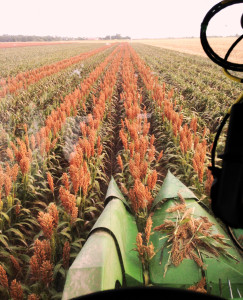College Station, Texas, USA
January 5, 2014
A Texas A&M AgriLife Extension Servicestate cropping system specialist hopes producers can use the weather forecast for not only deciding how to dress, but to alter management practices based on expected conditions.

Sorghum harvest on a Texas A&M AgriLife Extension Service plot testing the use of weather forecasts to reduce seeding rates if drier than normal conditions are expected. (Texas A&M AgriLife Extension Service photo by Dr. Ronnie Schnell)
The research project, “Optimizing Grain Sorghum Seeding Rates for Anticipated Hydrologic Conditions,” is led by Dr. Ronnie Schnell, AgriLife Extension specialist in the Texas A&M University soil and crop sciences department.
Joining Schnell in the research are Ryan Collet, AgriLife Extension agent in Hill County; Dr. Tony Provin, AgriLife Extension soil chemist, College Station; Russell Sutton, Texas A&M AgriLife Research associate research scientist, Commerce; and Jon Gersbach, AgriLife Extension agent for Milam County. This work was supported by the Texas Sorghum Producers.
“What we are trying to do with this project is determine: If we have an idea what the weather is going to be and the seasonal rainfall outlook, can we alter our management practices based on those long range forecasts?” Schnell said.
If the forecast can be utilized, he said, this could give producers an opportunity to reduce seeding rates significantly if drier than normal conditions are expected, as well as other yield-based inputs such as nitrogen to match anticipated moisture conditions.
“Excessive plant populations can exacerbate soil moisture limitations and result in lower yields, stalk rot diseases and lodging in grain sorghum,” Schnell said.
He said finding the optimum seeding rate is complicated by the variability of pre-season soil moisture and in-season precipitation.
In its first year, this study evaluated grain sorghum yield in response to increasing seeding rates and contrasting soil moisture conditions in the central and northern Blacklands of Texas.
The trials were imposed at five locations in the central and northern Blacklands. April and May precipitation was slightly below normal, while June precipitation was well above normal. Over the three months, precipitation was in line with forecasted conditions. Winter precipitation, although variable, had been sufficient to recharge the soil profile before planting.
“We looked at seeding rates and we wanted to know if we could identify optimum population rates for given hydrological conditions and then if we could use some of the long-term forecast to adjust our seeding rates,” Schnell said.
This year at planting time, precipitation was not expected to be above or below normal, so no adjustment to normal seeding rates would be justified.
“But, what we did see in June as the crop reached critical growth stages and water use started to peak was depletion of profile soil moisture,” he said. “This year we also had above-normal precipitation in June, so we had the water to replenish that profile. But we know the soil moisture was rapidly depleted during later growth stages, possibly resulting in brief periods of moisture stress at all locations.”
Without timely rainfall, moisture stress would have intensified and higher plant populations may not have been successful, Schnell said.
He said in this first year of testing, the optimum population rate for the sites was near what the normal recommendation would be because of the predicted moisture.
“We have to keep in mind that for this year we had a full profileat planting and had some very timely heavy rainfalls during the growth stages, so this year will represent a year where higher seeding rates would be successful,” Schnell said.
“However, there are other years that we suspect if we did not get normal rainfall, it would certainly justify reductions to those seeding rates and that would help to maintain and reduce some of the secondary issues you come up with when moisture is limited.”
Schnell said they will try to continue the study at some level next year and have a broader range of moisture-level conditions to compare.